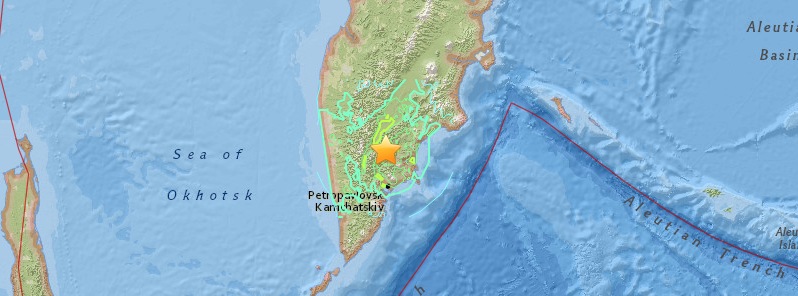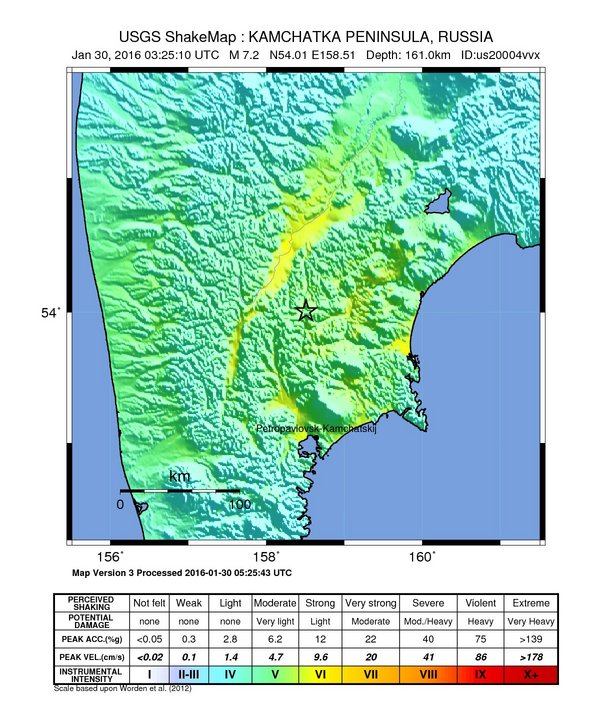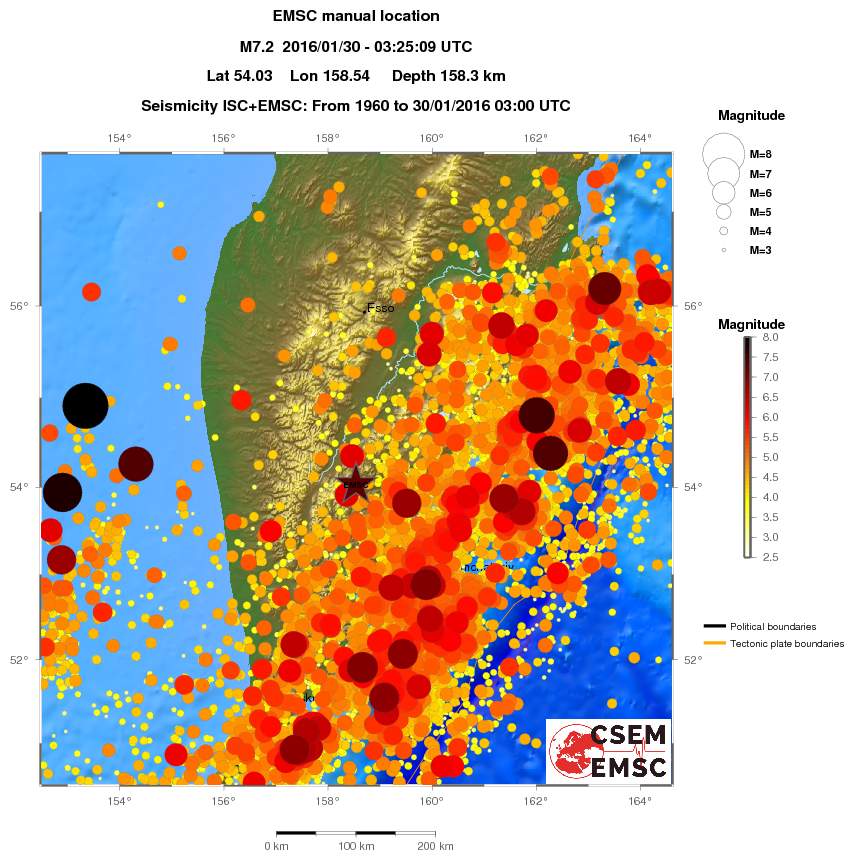Very strong M7.2 earthquake hit Kamchatka, Russia

A very strong earthquake registered by the USGS as M7.2 hit Kamchatka, Russia at 03:25 UTC on January 30, 2016. The agency is reporting a depth of 161 km (100 miles). EMSC is reporting M7.2 at a depth of 158 km. CENC is reporting M7.0 at the same depth.
According to the USGS, the epicenter was located 91 km (57 miles) N of Yelizovo, 107 km (66 miles) N of Petropavlovsk-Kamchatskiy, 119 km (74 miles) N of Vilyuchinsk and 776 km (482 miles) SE of Magadan, Russia.
There are about 65 764 people living within 100 km (62 miles) radius.

USGS issued a green alert level for shaking-related fatalities, there is a low likelihood of casualties, and a yellow alert level for economic losses. Some damage is possible, and the impact should be relatively localized. Estimated economic losses are less than 1% of GDP of the Russian Federation. Past events with this alert level have required a local or regional level response.
Overall, the population in this region resides in structures that are a mix of vulnerable and earthquake resistant construction.

According to the USGS, the quake occurred as the result of oblique-normal faulting at a depth of 180 km (111 miles). At the location of this earthquake, the Pacific plate is moving towards the west-northwest with respect to the North America and Eurasia plates at a rate of approximately 77 mm/yr. Note that some authors divide this region into several microplates that together define the relative motions between the larger Pacific, North America and Eurasia plates; these include the Okhotsk and Amur microplates that are respectively part of North America and Eurasia. The depth and faulting mechanism of the January 30th earthquake indicate that it ruptured a fault within the subducting Pacific lithosphere.
Earthquakes like this event, with focal depths between 70 and 300 km (45 – 190 miles), are commonly termed "intermediate-depth" earthquakes. Intermediate-depth earthquakes represent deformation within subducted slabs rather than at the shallow plate interface between subducting and overriding tectonic plates. They typically cause less damage on the ground surface above their foci than is the case with similar magnitude shallow-focus earthquakes, but large intermediate-depth earthquakes may be felt at great distance from their epicenters. "Deep-focus" earthquakes, those with focal depths greater than 300 km, also occur in the subducted Pacific plate beneath Kamchatka, and this slab hosted the largest ever-recorded deep earthquake, a M8.3 event in May 2013. The deepest reliably located earthquake in this region occurred at a depth of almost 650 km (403 miles).
The Kuril-Kamchatka arc has frequent moderate-to-large earthquakes, and has hosted over thirty M6.5+ events within 250 km (155 miles) of the January 30th earthquake over the past century. Most of these occurred on the shallow megathrust plate boundary; just three were at intermediate depths. The largest of these three was a M7.3 earthquake in November 1971, 140 km (87 miles) south-southeast of the January 30, 2016 event, at a depth of 125 km (77 miles). The shallow plate boundary in this region hosted a M9.0 earthquake in November 1952, resulting in a large tsunami that caused damage and fatalities along the coastlines of Kamchatka and the Kuril Islands, and which also caused significant damage in Hawai’i.
Seismotectonics of the Kuril-Kamchatka Arc
The Kuril-Kamchatka Arc extends approximately 2,100 km from Hokkaido, Japan along the Kuril Islands and the Pacific coast of the Kamchatka Peninsula, until terminating at its intersection with the Aleutian arc south of the Commander Islands, Russia. It marks the region where the Pacific plate subducts into the mantle beneath the Okhotsk mircoplate, a proposed regional subdivision of the larger North America plate. This subduction is responsible for the generation of the Kuril Islands chain, volcanoes along the entire arc, and the deep Kuril-Kamchatka Trench. Relative to a fixed North America plate, the Pacific plate is moving northwest at a rate that increases from 79 mm/yr near the northern end of the arc to 83 mm/yr adjacent to Hokkaido.
In the southern section of the Kuril arc oblique subduction results in the partitioning of stress into both trench-normal thrust earthquakes (e.g., the 12/03/1995 M 7.9 Kuril Island event) and trench-parallel strike-slip earthquakes (e.g., the 10/16/1994 M 6.7 Kuril Island event). This oblique convergence also drives the southwestern translation of the Kuril Arc, and its collision with the Japan Arc. The collision in turn drives the uplift of the Hidaka Mountains, and causes northwest-southeast oriented compressional earthquakes across Hokkaido.
North of approximately 44° latitude, adjacent to the island of Urup, convergence becomes dominantly trench normal. In this area, cross-sections of the subduction zone reveal a well-defined Wadati-Benioff zone extending to depths of 650 km, supporting assumptions that the Pacific plate is relatively old and has been subducting for close to 100 Myr. As the arc approaches its northern terminus off the coast of the Kamchatka Peninsula, the character of subduction changes again due to the entrainment of the Meiji Seamount and the influence of transform motion along westernmost extent of the Aleutian Arc. The angle of subduction decreases from 55 to 35 degrees from south to north, and the maximum depth of seismicity decreases from ~600 km to ~200 km, causing a northwestern deviation in the volcanic front.
The Kuril-Kamchatka Arc is one of the most seismically active regions in the world. Deformation of the overriding North America plate and associated microplates generates shallow crustal earthquakes, while slip at the subduction zone interface between the Pacific and North America plates generates interplate earthquakes that extend from near the base of the trench to depths of 40 to 60 km. The aftershock zones of great historic earthquakes abut one another along the strike of the arc but generally do not overlap; sections of the subduction zone have typically experienced earthquakes of a consistent size at fairly regular recurrence intervals, though the length of seismicity catalogs is typically shorter than the expected repeat times of the largest earthquakes known to have occurred in the region.
Patterns in along-arc seismicity can reveal seismic gaps, zones where no great ruptures have occurred for an anomalously long period of time. In the Kuril region, a gap between Simushir Island and Onekotan Island that had remained unruptured by a large earthquake since 1780 was the site of an M 8.3 event on November 15, 2006. Minutes after the November 15 earthquake, aftershocks began rupturing one or more faults near the outer rise region seaward of the Kuril-Kamchatka Trench, adjacent to the location of the main shock. On January 13, 2007, two months after the 2006 event, a great (M 8.1) normal faulting earthquake occurred in this same region. Because the January 2007 event ruptured within the aftershock zone of the November 2006 quake, it is speculated to be the result of changes in the regional stress field following the earlier event, despite occurring on a different fault. The inferred coupling of the 2006 and 2007 events make them one of the largest earthquake doublets to have ever been recorded.
The Kuril-Kamchatka region frequently experiences large (M≥7) and great (M≥8) earthquakes. In the 114 years since 1900, 133 large and 12 great earthquakes have occurred along the arc. Damaging tsunamis followed several of the large interplate megathrust earthquakes, including the September 25, 2003 M 8.3 Hokkaido earthquake, and the November 6, 1958 M 8.4 Etorofu event. The February 3, 1923 M 8.4 Kamchatka earthquake generated an 8 m transoceanic tsunami. On October 13, 1963, a M 8.5 megathrust earthquake off the coast of the island of Urup generated a large tsunami in the Pacific Ocean and the Sea of Okhotsk, with run-up wave heights of up to 4-5 m.
The largest megathrust earthquake to occur along the arc in the 20th century was the November 4, 1952 M 9.0 event, to date the 5th largest instrumentally recorded earthquake in history. This earthquake was followed by a devastating tsunami with run-up wave heights as high as 12 m along the coast of Paramushir, causing significant damage to the city of Severo-Kurilsk. Intraplate earthquakes have also been known to cause significant damage in the region. On October 4, 1994, a large (M8.3) intraplate event occurred within the subducted oceanic lithosphere of the Pacific plate off the coast of Shikotan Island, causing intense ground shaking, landslides, and a tsunami with run-up heights of up to 10 m on the island.
While most large earthquakes along the Kuril-Kamchatka Arc occur at shallow or intermediate depths, the region also hosts large events that rupture at depths greater than 300 km. The most significant of these deep-focus earthquakes to date was the May 24, 2013 M 8.3 event beneath the Sea of Okhotsk, currently the largest deep-focus earthquake on record. The earthquake occurred as the result of normal faulting within the subducted Pacific slab approximately 600 km below the Earth's surface, and was felt as far away as Moscow, Russia, nearly 6,500 km to the west. (USGS) More information on regional seismicity and tectonics
Featured image credit: USGS

Commenting rules and guidelines
We value the thoughts and opinions of our readers and welcome healthy discussions on our website. In order to maintain a respectful and positive community, we ask that all commenters follow these rules:
We reserve the right to remove any comments that violate these rules. By commenting on our website, you agree to abide by these guidelines. Thank you for helping to create a positive and welcoming environment for all.